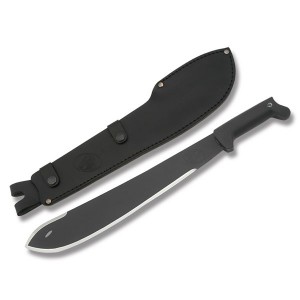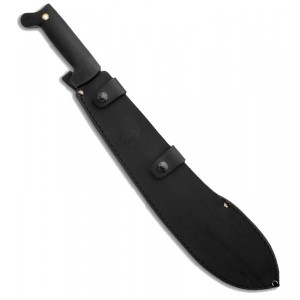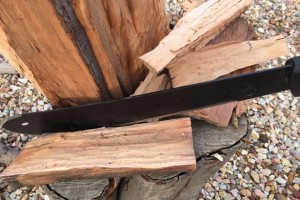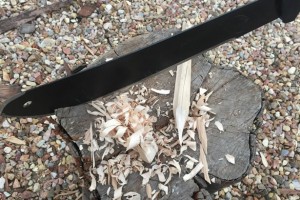Condor CTK227-15HC Bolo Machete Reviewed

Marketing from Condor Tool & Knife
Condor’s CTK227-15HC Bolo Machete has been created to be the ideal blade for any outdoorsman. This Machete from the experts at Condor is made from an epoxy black powder coated 15.5″ 1075 high carbon steel blade and a 5.5″ black high-impact polypropylene handle that offers an amazing grip in any condition. The leather sheath that comes with the Condor Bolo Machete Knife will make sure that your blade remains protected.
Manufacturer: Condor Tool & Knife, www.condortk.com
Model: CTK227-15HCOverall Length: 21″ (53.34 cm)
Blade Steel: Black Powder Coated 1075 High Carbon Steel Blade
Blade Thickness: 1/8″ (3 mm)
Blade Length: 15.5″ (39.37 cm)
Handle Material: High Impact Polypropylene Handle
Handle Length: 5.5″ (13.97 cm)
Weight: 1.39 lbs.
Accessories: Leather Sheath w/Swiveling Belt Loop
Warranty: Limited Lifetime Warranty
Origin: Made in El Salvador
UPC: 7417000528978
MSRP: $59.98
The Review
As part of my endless search for reliable survival gear, I look for products that can perform a multitude of tasks. Single-purpose gear just won’t cut it when you only have a limited amount of space and weight available. In this review, we’ll be looking at Condor’s CTK227-15HC Bolo Machete and how well it can perform basic bushwhacking and bushcraft tasks. Can it eliminate the need to carry a separate hatchet, knife and machete.

Initial Thoughts
After opening the box and pulling out Condor’s Bolo Machete, I was immediately impressed with the extremely high-quality of the black leather sheath. Its not very often that this nice of a sheath is provided with a blade under a hundred bucks, much less the sub-$60 price tag of this blade.
The handle is made from a high-impact polypropylene with a nice, comfortable palm-swell. However, the grip does feel a little slick for my taste. I would really like to try out their other model (CTK227-15HCM) with the Micarta handle. It may be better-suited for wet conditions.
 With an overall length of 21-inches, this Bolo Machete is very well balanced and easy to wield. The 1/8-inch, 15.5-inch long 1075 high-carbon steel full-tang blade is stout and arrives very sharp and ready to go.
With an overall length of 21-inches, this Bolo Machete is very well balanced and easy to wield. The 1/8-inch, 15.5-inch long 1075 high-carbon steel full-tang blade is stout and arrives very sharp and ready to go.
Features
Now lets focus on the CTK227-15HC’s features in more detail…
The Blade
Known throughout South East Asia and Pacific Rim, the Bolo Machete is a compact, weighted machete good for chopping woody vegetation. It features a wider fore-blade adding to the centrifugal force of a swing for better chopping and slashing power.
Condor machetes are known as rugged and durable tools and the CTK227-15HC Bolo Machete is no exception. Its 1075 high carbon steel and full-tang blade is hollow-ground and designed to be worked hard and still hold on to its edge.
The CTK227-15HC’s 1075 high carbon steel is a very tough steel well-suited for blades designed specifically for chopping so it is the perfect alloy for a machete, whereas 1095 high carbon steel would be much better suited for blades where edge retention is key like a good survival knife. Both alloys are typically easier to field-sharpen than stainless steel blades of a similar hardness.
Even with the protective epoxy powder coating, the 1075 high carbon steel blade is still susceptible to rust without proper care and maintenance. If the blade becomes wet, dry it off thoroughly and lightly coat it with some oil like Break-Free CLP before putting it away. If you do, it could last you a lifetime.
 The Handle
The Handle
The handle is made from a virtually indestructible high-impact polypropylene molded directly onto the machete so the handle is not at all removable. The handle has a comfortable grip and palm-swell. However, the grip does feel a little slick for my taste, especially when wet. Although, with a smoother grip surface, gloves are not really necessary.
The full-tang blade steel continues through to the end of the handle with what looks like a brass bushing passing through the blade and molded into handle making the lanyard hole. Simply attach a length of 550-Paracord and you’re ready to go.
The Sheath
The CTK227-15HC includes a very nice embossed black leather sheath. The sheath is well made from two thick leather slabs and a leather spacer glued and single-stitched together with a rivet at each corner. Two straps with button snaps are riveted in place to hold the blade firmly in place. The belt loop will accommodate a 2-inch belt and is attached with a single rivet allowing it to swivel.
It would have been nice had Condor provided other mounting options on this sheath like a MOLLE system in addition to a hole at the end of the sheath protected by eyelets for a simple leg strap.
Functional Testing
Now lets see how Condor’s Bolo Machete performs… In order to provide a some sort of apples-to-apples comparison between blades, I will be performing five durability tests; Batoning, Chopping, Feather Stick, Tip Strength and Edge Retention. In a survival situation, all resources are fair game. However, since I am not in a life-or-death situation, I’ll stick to some seasoned wood that I have lying around for these tests.
Batoning
Per Wikipedia: Batoning is the technique of cutting or splitting wood by using a baton-sized stick or mallet to repeatedly strike the spine of a sturdy knife, chisel or blade in order to drive it through wood. The batoning method can be used to make kindling or desired forms such as boards, slats or notches. The practice is most useful for obtaining dry wood from the inside of logs for the purpose of fire making.
To test the CTK227-15HC’s ability to be used with a baton to make kindling I found a couple of 4″ logs about 12″ long, and a 2″ stick about 18″ long to use as my baton. I placed the first log on its end and began to whack both sides of the CTK227-15HC evenly with the baton until it sliced through the entire log and repeated a few more times until all of the material was reduced to a pile of small kindling.
Next, I thought it would be a good time to try the CTK227-15HC and the baton on some heavier material. I began by sectioning off some kindling from a larger stump about 12″ in diameter. This is typically done by splitting off 1-2″ slices from the outer-edge of the stump, parallel to the ring-line. I worked my way around the stump, slowly moving inward.
 Even with all of the knots, the CTK227-15HC and baton performed fairly well on the smaller material. Although, it did require quite a bit of force to split the smaller logs. Due to the shape, thickness (or lack thereof) and angle of the blade’s edge, the larger material seemed impossible. I found that unless the material is soft like a pine or fir, it just required too much effort to rip through the material.
Even with all of the knots, the CTK227-15HC and baton performed fairly well on the smaller material. Although, it did require quite a bit of force to split the smaller logs. Due to the shape, thickness (or lack thereof) and angle of the blade’s edge, the larger material seemed impossible. I found that unless the material is soft like a pine or fir, it just required too much effort to rip through the material.
Additionally, the CTK227-15HC’s long-thin spine do not provide a good flat surface to strike with the baton. The baton kept breaking as it struck the spine with any considerable force. As a result, the CTK227-15HC did not perform well with a baton.
Chopping
In order to prepare some logs for this test, I had to strip the twigs and small branches from the main branches that I will be working with. The CTK227-15HC performed very well at removing this growth off just as you would expect from any good machete. Next I began to chop a branch approximately 3-4″ in diameter. At nearly 1-1/2 pounds, the CTK227-15HC’s weight provides plenty of striking force.
When chopping, or cross-cutting a log you simply strike the log at a 45° angle from two perpendicular directions along the cut-line, effectively making a “V” in the material used to be, otherwise known as the kerf. The kerf should equal the diameter of the trunk, and when cutting from both sides, the kerf would essentially be half diameter.
While the CTK227-15HC is not specifically designed for heavy chopping, with its weight and sharpness I was able to chop through the logs. However, if you need to swing the blade for any length of time, I thoroughly recommend wearing gloves to protect your hands and absorb some of the shock.
The CTK227-15HC performs very well with light material like limbs smaller than 2″ in diameter. But it did not with the larger material. In fact, it was a huge struggle. However, it would likely get the job done in a pinch. Having a hatchet or small axe with you would be a much better choice for tasks like this one.
Feather Stick
Per Wikipedia: A feather stick (sometimes referred to as a fuzz stick) is a length of wood which is shaved to produce a head of thin curls protruding from the wood. It is used for damp wood to start a fire (or campfire) when dry tinder is hard to find.
For this next test, I will be making a simple feather stick from a stick about 1-1/2″ in diameter and a little shy of 12″ long. I found the CTK227-15HC worked best by setting it deep into a stump at an 45° angle so my leg could support the end of the handle. Then I proceeded to shave 2-3″ curls otherwise known as “feathers” all the way around the stick, starting at the bottom-end then slowly working my way up. I found the blade area nearest to the handle to be the sweet-spot for feathering the stick.
 As I continued my way around the stick, I was careful not to cut the curls too deep causing them to break off. About 6″ up I began to work my way around deeper and deeper into the stick until I was almost all the way through. Then I snapped the feathered section off leaving what can only be described as a 6″ tall pinecone. I had a finely-feathered stick to start a fire.
As I continued my way around the stick, I was careful not to cut the curls too deep causing them to break off. About 6″ up I began to work my way around deeper and deeper into the stick until I was almost all the way through. Then I snapped the feathered section off leaving what can only be described as a 6″ tall pinecone. I had a finely-feathered stick to start a fire.
The CTK227-15HC performed very well at creating a feather stick. The sharp hollow-ground edge shaved perfect curls. Its length and fixed position made it much easier to control and maneuver the material around it.
Tip Strength
To test the CTK227-15HC’s ability to stab or pierce without the tip bending or breaking, I drove the tip end of the blade into the end of a 12″ stump as hard as I could. Then I loosened the blade using a side-to-side motion until it was loose enough to pull out. I repeated this action four more times without any sign of damage. However, I felt that moving the blade in the other direction could possibly result in bending or breaking the tip.
I also used the CTK227-15HC to bore a cone-shaped hole into the side of a small log approximately 1″ in diameter and about 1/2″ deep by rotating the blade. The CTK227-15HC performed this task without issue.
Edge Retention
Even after all of the other functional tests were completed, the CTK227-15HC easily sliced through a single sheet of paper without issue. My testing left no sign of cracks, chips or imperfections of any kind with the exception of some slight wear on the blade’s protective coating. The CTK227-15HC held its edge and remained very sharp through the entire process, even with all of the punishment that I threw at it.
Final Thoughts
Condor’s CTK227-15HC is an excellent bolo machete. The blade pattern, thickness and edge is specially designed to excel at hacking and slashing vegetation. That is why the CTK227-15HC is ideal for clearing overgrowth to widen a trail, removing underbrush from around your campground, and even for performing basic bushcraft tasks. However, no one tool is designed to excel at every single task that you might run across. As a result, when it comes to chopping and splitting heavy material, the light weight, thickness of the blade and shape of the grind is not very well suited so if you think you might need to work some large material, you should probably consider bringing along a small axe or hatchet along with you as well.
If you are bugging out or just trailblazing through an area with a lot of brush, the CTK227-15HC would be a pretty sweet tool to have on your belt or strapped to your pack. At a little less than $60, the CTK227-15HC is certainly an affordable option for anyone on a budget. I give this machete a big thumbs up, but I would sure love to try out the model with the micarta handle.
![]()
About Condor Tool & Knife
![]() Condor Tool & Knife offers a unique line of high quality, superbly designed tools for the outdoor enthusiast. Condor’s line of fine machetes, axes, knives and survival tools are made in Santa Ana, El Salvador to the highest technical specifications and will last a lifetime.
Condor Tool & Knife offers a unique line of high quality, superbly designed tools for the outdoor enthusiast. Condor’s line of fine machetes, axes, knives and survival tools are made in Santa Ana, El Salvador to the highest technical specifications and will last a lifetime.
--